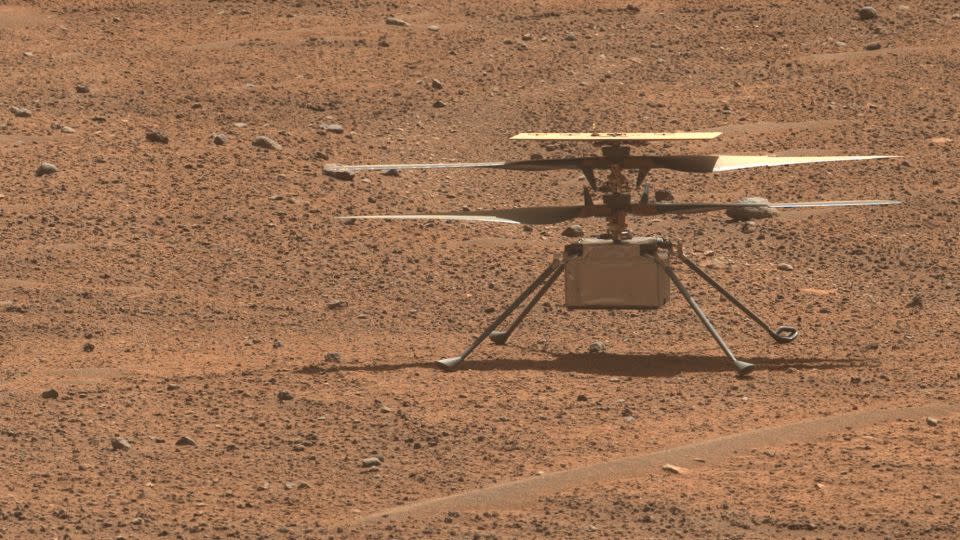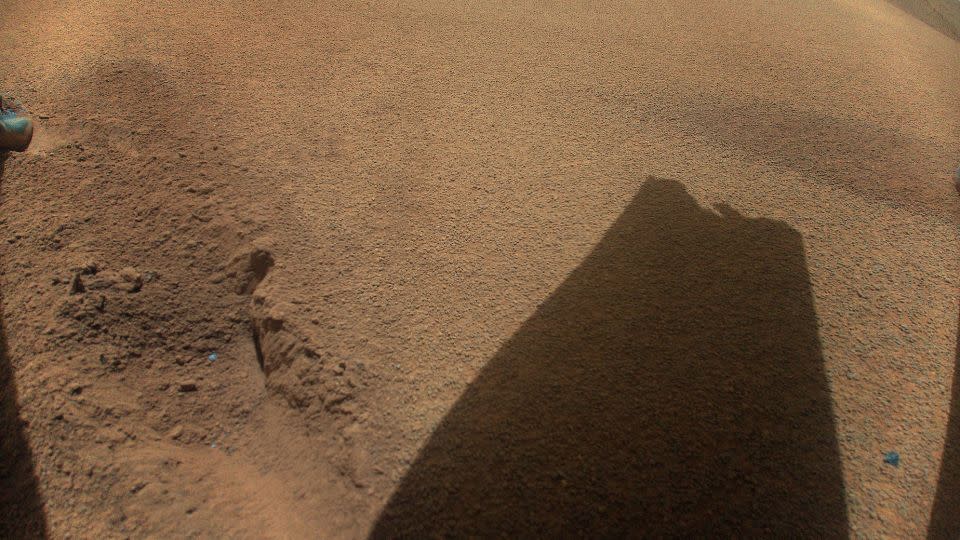Sign up for CNN’s Wonder Theory science newsletter. Explore the universe with news about fascinating discoveries, scientific developments and more.
After completing 72 historic flights on Mars in three years, NASA’s Ingenuity helicopter mission has ended.
Originally designed as an experiment, Ingenuity became the first aircraft to fly on another world, taking off on April 19, 2021.
Imagery and data sent back to NASA’s Jet Propulsion Laboratory in Pasadena, California, showed that one or more of the helicopter’s carbon fiber rotor blades were damaged during landing during its final flight this month. The team determined that the helicopter could no longer fly, the space agency said.
Ingenuity, which traveled to Mars as the Perseverance rover’s faithful sidekick, sits upright on the red planet’s surface, and mission controllers from NASA’s Jet Propulsion Laboratory have been able to maintain communications with the chopper.

The NASA mission team only expected the helicopter to perform five test flights in 30 days. After completing its five expected flights, Ingenuity graduated from its role as an experiment to serving as an aerial scout for the Perseverance rover. The helicopter flew over areas of scientific interest to capture images and help the mission team determine Perseverance’s next targets for detailed analysis. The helicopter performed its last flight on January 18.
Together, the rover and helicopter have spent the past few years exploring the Jezero crater, the site of an ancient lake and river delta on Mars. Scientists hope that samples collected by Perseverance, which will be returned to Earth by future missions, can determine whether life ever existed on the red planet.
“The historic journey of Ingenuity, the first aircraft on another planet, has come to an end,” NASA Administrator Bill Nelson said in a statement. “That remarkable helicopter flew higher and further than we ever imagined and helped NASA do what we do best: make the impossible possible. Through missions like Ingenuity, NASA is paving the way for future flights in our solar system and smarter, safer human exploration to Mars and beyond.”
In addition to achieving the Wright brothers’ first moment on another planet, Ingenuity has recorded many milestones. It flew 14 times further and 33 times longer than planned, recording more than 2 hours of flight time.
“At NASA JPL, innovation is at the core of what we do,” Laurie Leshin, director of the Jet Propulsion Laboratory, said in a statement. “Ingenuity is an example of how we push the boundaries of what is possible every day. I am incredibly proud of our team behind this historic technological achievement and look forward to seeing what they will invent next.”
What went wrong
Ingenuity was scheduled to make a short vertical flight, known as a hop, on January 18 to help the mission team pinpoint its exact location. The helicopter made an emergency landing during its previous flight, Flight 71.
During Flight 72, Ingenuity rose approximately 40 feet into the air, hovered for 4.5 seconds and began descending at a rate of 3 feet per second.
But when the helicopter was 1 meter above the surface of Mars, the mission team lost communication with Ingenuity as it stopped sending data to the rover. The helicopter relies on Perseverance to serve as a communications relay, as Ingenuity has no way to send or receive data to Earth on its own.


The next day, communications with Ingenuity were restored, allowing the mission team to analyze flight data and view images showing at least one damaged rotor blade.
The team is still investigating the cause of the communications failure and the orientation of the helicopter when it landed.
It’s possible that one of the blades hit the ground during landing, Nelson said.
Now the team will run some final tests with Ingenuity and download the rest of the data and images. Currently, the rover is too far away from Ingenuity to capture images of the helicopter.
The legacy of ingenuity
The end of the mission is “bittersweet,” as Nelson said, but the helicopter has exceeded expectations for so long. The mission team overcame numerous challenges to ensure Ingenuity continued to fly well beyond its expected lifespan.
Over the course of its mission, Ingenuity has undergone multiple software upgrades to help it fly over treacherous terrain, clean itself up after dust storms, survive the freezing Martian winter, perform three emergency landings, have a dead sensor and conduct operations from 48 different locations. .
Ingenuity’s mission began in the spring, when conditions on Mars were warmer and brighter. But as winter approached on Mars in June 2022 and the mission exceeded its original goals, Ingenuity did not have enough power to keep itself warm during the frigid nights. As a result, the helicopter’s flight computer frequently froze and reset, causing multiple brownouts.


All the data collected during the long duration of the Ingenuity mission will help future helicopter designs explore Mars and other worlds in the future.
“It is humbling that Ingenuity not only has a sample of the original Wright Flyer on board, but also that this helicopter followed in its footsteps and proved that flight to another world is possible,” said Teddy Tzanetos, Ingenuity’s project manager at JPL, in a statement. “The Mars Helicopter would never have flown once, let alone 72 times, without the passion and dedication of the Ingenuity and Perseverance teams. History’s first Mars helicopter will leave an indelible mark on the future of space exploration and will inspire aircraft fleets on Mars – and other worlds – for decades to come.”
For more CNN news and newsletters, create an account at CNN.com